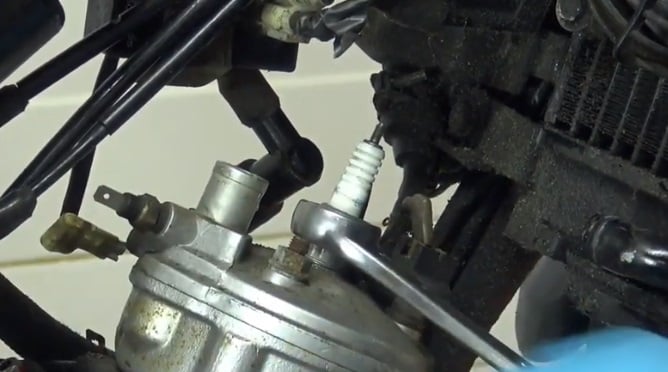How to replace your spark plug?
Necessary tools : Spark plug wrench, feeler gauge
1 - The first thing to do is to remove the antiparasite fixed on the spark plug by pulling on the suppressor itself and not on the wire. Then remove the casings or covers which may prevent access to the spark plug.

2 - Very important : Clean the spark plug well with a brush or a compressed air blower to release any impurities that could fall into the cylinder when you remove the spark plug. Loosen the spark plug one or two turns and start the cleaning operation again, to remove the last dirt that could remain stuck.
3 - If the spark plug is blocked: try to unblock it by forcing with a spark plug wrench more suitable (sometimes a longer lever is enough). If it still resists, run your engine for a few minutes. Expansion of the cylinder head may solve the problem. If it is unlocked, but it resists unscrewing a little too much, spray with penetrating.
Terminal cleaning:
First of all remember that cleaning the spark plug is only valid on a spark plug that is going well, or in the case of a greasy spark plug, or just blackened with soot. In the case of a bleached, vitrified or melted spark plug, it must be replaced. Filing a scorched spark plug is useless.
To clean spark plugs, use a candle brush (in copper to avoid damaging the insulators). Important: keep your spark plug turned with the terminals down, so that the debris does not fall into the cylinder.
Terminal spacing adjustment:
With wear and time, the spark plug terminals tend to move apart and the spark (electric arc) is less effective, resulting in starting problems.
To adjust the terminal spacing, you need a set of shims or feeler gauge. Then you need to read the spacing indicated on the spark plug. Then, insert the corresponding shim between the two terminals, and delicately, with a small hammer or ideally a piece of rigid wood, bring the spacing back to its correct value, by gently tapping on the terminal.
4 - Place your cleaned spark plug (or your new spark plug) and screw there first with your fingers, it is very important. If you do not enter straight it will block, whereas with the spark plug remover you risk "messing up the thread" of the cylinder head. Screw it on several turns, ideally up to the sealing joint.
Tip: put a drop of copper grease, or graphite grease on the thread of the spark plug you are installing. It will be removed more easily during your next spark plug removal operation.
5 - Once the candle is screwed in by hand, finish with the spark plug remover. To ensure ideal tightening, it is best to have a torque wrench and to respect the tightening torque indicated par the constructor. If you don't have one, it is generally advised (once the sealing washer is seated on the cylinder head) to make a 1/2 turn to 3/4 turns blockage. (Depending on whether the spark plug has already been used or not, and therefore whether the seal has already been crushed, or not).
Advice: If you do your maintenance yourself: chain maintenance, oil change, replacement of brake pads, cleaning or replacement of the air filter... Do not hesitate to invest in a torque wrench, Car the tightening torque is very important!

6 - Before replacing theantiparasitic, take the opportunity to clean it (compressed air, brush, alcohol, etc.). The contact surfaces must be perfectly neat and clean. If it is oxidized, renovate and test it, or change it.











